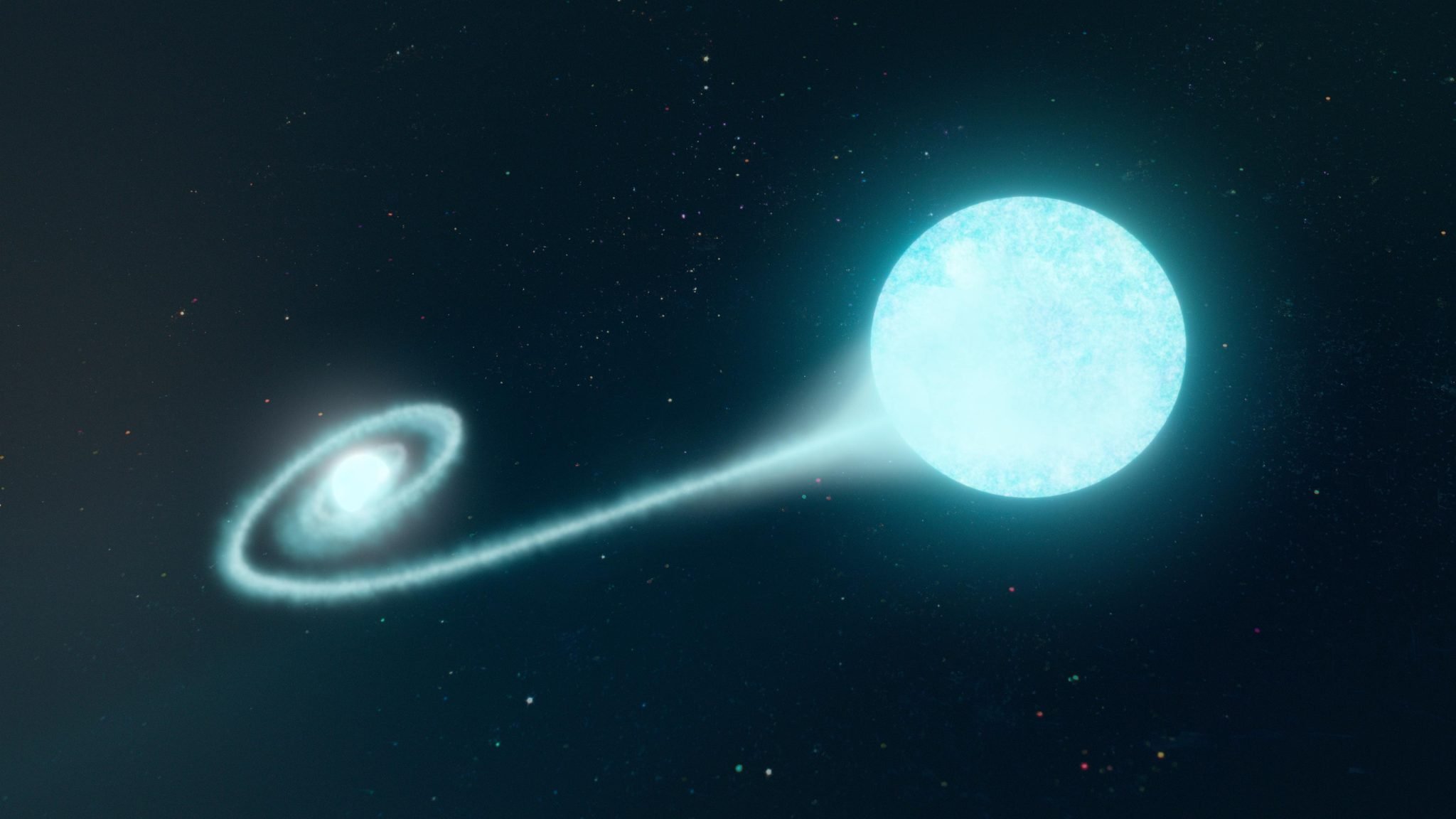
Deteksi pertama gelombang radio Supernova Tipe Ia
oleh

Penggambaran artis tentang SN 2020eyj, bintang kerdil putih yang menjadi supernova setelah materi disedot dari bintang pendamping helium. Kredit: Observatorium Adam Makarenko/WM Keck
Para astronom di Universitas Stockholm telah menemukan supernova Tipe Ia yang tidak biasa. Untuk pertama kalinya terdeteksi dalam gelombang radio dan menunjukkan emisi helium yang kuat. Supernova dipicu oleh a[{” attribute=””>white dwarf star that pulled helium-rich material from a companion star. This novel finding adds to our understanding of Type Ia supernovae, which are pivotal for measuring the universe’s expansion.
A team of astronomers led by Stockholm University has discovered an unusual Type Ia supernova – or thermonuclear supernova – called SN 2020eyj. Not only did they make the first detection of such a supernova in radio waves, follow-up observations from W. M. Keck Observatory on Maunakea, Hawaiʻi Island also showed strong emission lines of helium.
This marks the first confirmed Type Ia supernova triggered by a white dwarf star that pulled material from a companion star with an outer layer consisting primarily of helium; normally, in the rare cases where the material stripped from the outer layers of the donor star could be detected in spectra, this was mostly hydrogen.
Type Ia supernovae are important for astronomers since they are used to measure the expansion of the universe. However, the origin of these explosions has remained an open question. While it is established that the explosion is caused by a compact white dwarf star that somehow accretes too much matter from a companion star, the exact process and the nature of the progenitor is not known.
The new discovery of supernova SN 2020eyj is evidence the companion star was a helium star that had lost much of its material just prior to the explosion of the white dwarf.
The study, which includes data from Keck Observatory’s Low Resolution Imaging Spectrometer (LRIS), is published in the May 17th issue of the journal Nature.
Kesan seorang seniman tentang sistem bintang ganda dengan bintang kerdil putih kompak yang mengakresi material dari pendamping donor yang kaya helium, dikelilingi oleh material padat dan berdebu. Interaksi antara bintang yang meledak dan material sisa pendamping inilah yang memunculkan sinyal radio yang kuat dan garis helium yang jelas dalam spektrum optik SN 2020eyj. Kredit: Observatorium Adam Makarenko/WM Keck
“Begitu kami melihat tanda-tanda interaksi yang kuat dengan bahan pendamping, kami juga mencoba mendeteksinya dalam emisi radio,” kata Erik Kohl, seorang peneliti pascadoktoral di Departemen Astronomi di Universitas Stockholm dan penulis utama makalah tersebut. “Deteksi di radio adalah yang pertama dari supernova tipe Ia – sesuatu yang telah coba dilakukan oleh para astronom selama beberapa dekade.”
Supernova 2020eyj pertama kali diamati oleh Zwicky Transit Facility di Observatorium Palomar dekat San Diego di mana Oskar Klein Center di Universitas Stockholm menjadi anggotanya.
“Teleskop Optik Utara di La Palma adalah kunci untuk mengikuti supernova ini,” kata Jesper Sollerman, profesor di Departemen Astronomi di Universitas Stockholm dan rekan penulis makalah tersebut. “Sama seperti spektrum dari Teleskop Large Keck di Hawaii yang segera mengungkap materi yang didominasi helium yang sangat tidak biasa di sekitar bintang yang meledak.”
“Ini jelas merupakan supernova Tipe Ia, tetapi masih terkait dengan yang kita gunakan untuk mengukur perluasan alam semesta,” tambah rekan penulis Joel Johansson dari Departemen Fisika Universitas Stockholm. “Sementara supernova Tipe Ia yang normal sepertinya selalu meledak dengan kecemerlangan yang sama, supernova ini memberi tahu kita bahwa ada banyak jalur berbeda untuk meledakkan bintang kerdil putih.”
Untuk informasi lebih lanjut tentang penelitian ini, lihat Sinyal Radio Mengungkap Asal Ledakan Supernova Termonuklir.
Referensi: “Supernova Tipe Ia yang terdeteksi radio dengan Bahan Kaya Helium” oleh Erik C. Kool, Joel Johansson, Jesper Sollerman, Javier Moldón, Takashi J. Moriya, Seppo Mattila, Steve Schulze, Laura Chomiuk, dan Miguel Pérez-Torres, Tersedia di sini Chelsea Harris, Peter Lundqvist, Matthew Graham, Sheng Yang, Daniel A. Burley, Nora-Lynn Strutjohan, Christopher Fremling, Avishai Gal-Yam, Jeremy Lesmi, Kate Maguire, Connor Omand, Matthew Smith, Igor Andreoni, Eric C . Bellem, Joshua S. Bloom, Keshalai D, Stephen L Groome, Mansi M Kasliwal, Frank J Massey, Michael S Medford, Sungmin Park, Josiah Purdum, Thomas M Reynolds, Red Riddell, Estelle Robert, Stuart D Rider, Yashvi Sharma & Daniel Stern 17 Mei 2023, Tersedia di sini. alam.
doi: 10.1038/s41586-023-05916-w
About The Author

“Penggemar musik yang ramah hipster. Analis. Praktisi bir. Perintis twitter yang sangat menawan. Communicator.”
